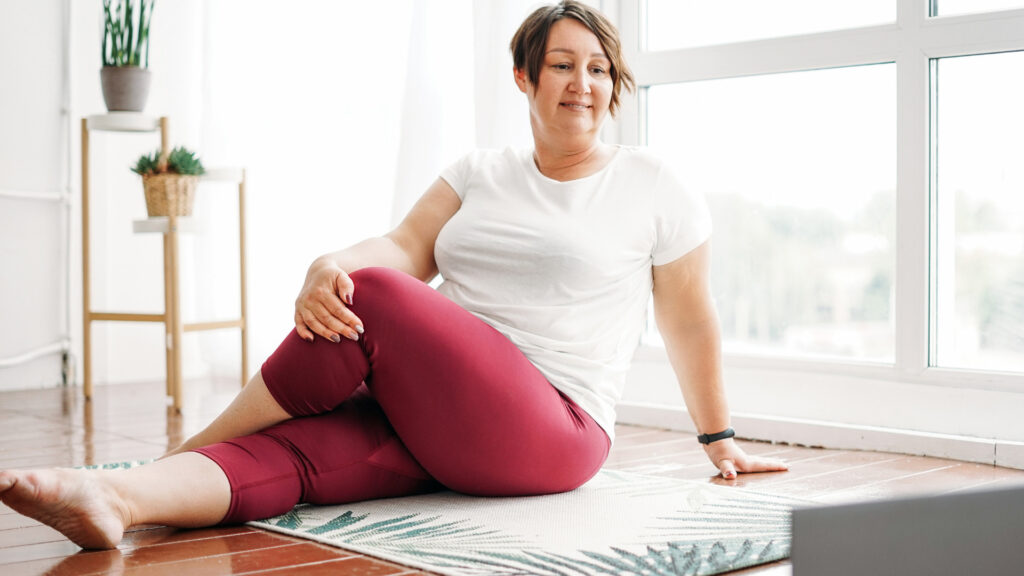
Yoga is for everybody. If our intention is to help provide tools to facilitate all levels of accessible classes, and to meet students where they are in their practice regardless of flexibility, age, size, shape, or ability level, we must be willing to put in the work as the teacher to explore options, become familiar with props, and be prepared to add variety to the shapes we are creating. From the moment we step on the mat, it becomes about the student. Our job as a teacher is to hold a compassionate, clear, projection-free container while the student moves through their experience. This allows the student to experience the benefits of yoga fully.
In order to add choice and option to the postures we are cueing, we need to remove expectations around poses looking a specific way. There are three simple ways you can promote exploration and adjustment in postures for yourself and your students. These are three suggestions you can begin to put to work into your teaching style.
The first suggestion is to adjust the base of the pose. By widening your stance in a posture that feels unstable, we help to create a more supportive base for the student and the pose. This can be helpful in postures like pyramid pose, Warrior 1, Warrior 2, and chair pose.
The second suggestion is to shorten the stance. Notice what it feels like to shorten the stance in a pose like Warrior 1, Warrior 2, or crescent lunge. By shortening the stance we are able to help provide a little more support and control, allowing ourselves and our students to find ease in the posture.
The third recommendation is to remind the participant that they can add a micro bend in their knees. This can be a game-changer for postures like forward fold, wide-legged fold, tree pose, and triangle pose where we may have the habit of locking out our knees. When exploring adjustments and different expressions of common yoga postures the two things to reflect on and ask ourselves in addition to the suggestions above are 1) What can we do to support our students and ourselves in practice? And 2) How can we meet everyone exactly where they are on their journey?
Yoga props and bolsters are key to creating a comfortable, accessible environment. Props are a beautiful way to create more accessible shapes in your yoga practice. Through the support of blocks, bolsters, and straps we are given the freedom to experiment with moving into postures in a different way, we are also given the choice to decide how deep we want to move into a pose. Using blocks in poses like triangle pose and half-moon pose allows us the confidence to move deeper into sensation while feeling the support of the block beneath our palm, or try something new like launch forward into our half-moon pose, knowing the block is there to bring the earth a little closer to our hand.
We can encourage our students to experiment with blocks in their own practice by demonstrating with blocks ourselves, and by cueing each student to reach for blocks as part of their setup while preparing for class. If the yoga teacher encourages the use of props from the outset, the student will be more open to asking for and using props. Bolsters are an essential part of creating comfort and ease in supported heart openers, allowing for a softer surface to melt into for savasana, and providing a wider softer space than what the mat alone can provide for a supported child’s pose or seated wide-legged fold.
Straps are a useful tool when experimenting with binds and deeper backbends like dancer’s pose and floor bow. By using the strap we are able to experience a wide range of sensations in the posture, we are able to create more space if we are looking for less sensation, or we can tighten the strap if we are looking for a different expression of the posture.
Our bodies are different. No one’s body is exactly like another. Our difference in body shape, size, range of motion, strength, and ability should be celebrated! Next time you are on the mat or are in the seat of the teacher, experiment with props and notice what it feels like to embrace the use of props in our practice. We are all so wonderfully unique and each body creates an individual shape based on our own one-of-a-kind anatomy.
Arriving with a clear container begins with us and coming clean of our own personal projections and belief system. Through taking the time for svadhyaya and examining our material as it arises, we have the ability to create an inclusive container that feels accessible, welcome, and warm. If it is our goal to share yoga in the way that it is intended, yoga for everybody, then adding variations to poses, using props, and growing our sequences to meet all levels is a necessity as opposed to an afterthought. Interested in learning more about creating a space that is inclusive and adaptive? Consider our Yoga Alliance accredited Adaptive Yoga CEU to become a Certified Adaptive Yoga Teacher.
